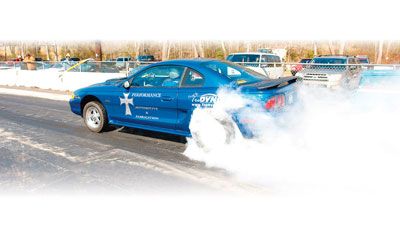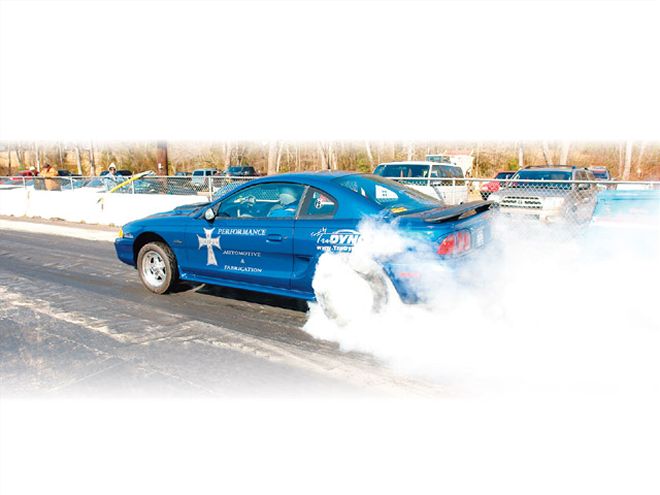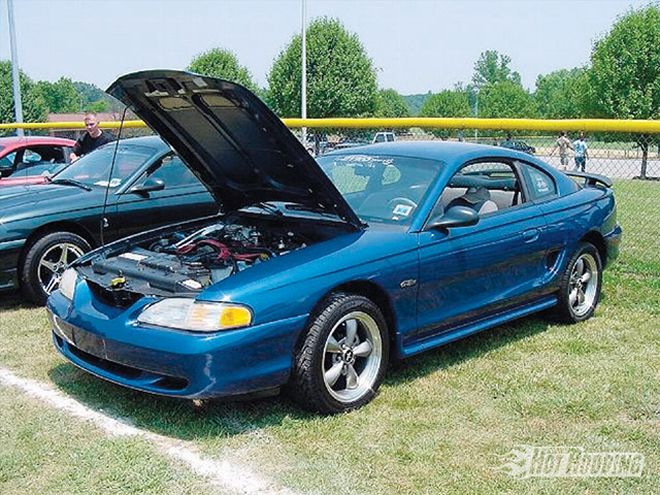

I have a passion for big-inch motors, and this has led me to ignore Ford's 4.6 Mod motor and its potential. What a mistake, and one we're about to rectify. The reality is that Ford's modular engine, especially the 4.6, is a cheap buy on the used market, and has way more potential than the modest displacement might suggest. But as Andy Wood of Cross Roads Performance (Gastonia, North Carolina) will demonstrate here, the lack of inches is not the big handicap you might think-as long as all mods are done right. In small, low-budget steps, we're going to show you what can be done for the mod motor.
Starting Point
The original plan was to install a low-mileage 4.6 from a bent '97 Mustang into an inexpensive '89 Fox-body rolling chassis. Mod motors have become popular for this and other transplants but wouldn't you know, running across an immaculate '96 Mustang with a large hole in the pan changed all that. So that good stock '97 motor went right into the '96, and that's where our investigation into mod motor speed starts. We started with proven mods demonstrated to work on many previous occasions. To understand how things progressed with the dyno numbers and drag testing, we'll discuss that here so you can see how we arrived at the final results.
The first move was to take the '96 over to Aaron Lail's Tru Dyno Sports (Hickory, North Carolina) where they dyno'd it on his Mustang chassis dyno. Everything was set to factory spec to establish a baseline rear-wheel power and torque curve. This proved to be 182 hp at the wheels. At Shadyside Dragway-our local eighth-mile track-the stock '97 stopped the clocks at 9.72/74.50 mph, which unofficially computes to a 15.97 at 84.71 mph for the quarter-mile.
Gears And Tires
This thing couldn't break the tires loose to save its life, and a lackluster 60-foot time prompted a rear-end change from the stock 2.73 ratio, to a 4.10 ratio. The green gear set with its lower ratio cost a little in the way of horsepower, but the rear-wheel torque in First gear was up by 33 percent, so the launch would be much better. After collecting a set of M&H slicks, we went back to the track and tested, with the eighth-mile result of 9.56/76.21.
 Late-model Mustangs look great, but compared to traditional muscle cars or their GM competition, they just aren't that fast. This '96 GT test mule looked really sharp with its replacement '97 engine installed, it just wasn't fast.
Late-model Mustangs look great, but compared to traditional muscle cars or their GM competition, they just aren't that fast. This '96 GT test mule looked really sharp with its replacement '97 engine installed, it just wasn't fast.
Cams And Exhaust
The next mods are being thrown in because the parts are readily available on the used market, and often at bargain prices. They don't produce earth-shattering results, but assuming a typical used price, they do represent a cost-effective move.
The parts we're talking about are a set of factory "performance improved" (PI) cams from a stock '99-04 Mustang, some Ford Racing shorty headers, and a MAC off-road H-pipe and mufflers. These mods turned 198 hp on the chassis dyno, for an increase of 19 hp over baseline.
Back at Shadyside, we found that the M&H slicks effortlessly planted the extra power, and our Mustang reeled off some consistent runs with the average at 9.17/78.10. This approximates a 14.98 e.t. for the quarter, so we have passed a significant milestone already.
Hot Cams And Compromises
Here we come to the first "speed secret" known by Mod motor specialists like Andy Wood. From many hours spent on the chassis dyno, Andy reports that a typical 4.6 engine produces the best results when the cam lobe centerline angle is at 108-109. But most cams sold are on a 113-114 LCA. Why? The problem is that the stock pistons have no valve pockets, so giving the engine what it actually wants on a cam of a little more than 225 degrees at 0.050 tappet lift is going to put valves and pistons in the same place at the same time.
Although Andy can cut piston valve pockets with the short-block still in the car, it is not a cost-effective procedure unless the heads have to come off to install a ported set. For this test, we left the pistons stock, and installed Sean Highland Motorsports (SHM) 2730 cams. This is a 230/230 by 114 LCA grind that delivers 0.495-inch lift. Back on the chassis dyno, we found the cams to be worth power from about 3,800 on up, with the peak output increasing to 215 hp at the tires. At the track, another goal was reached in that we went under the 9-second mark for the eighth-mile. The timeslip now read 8.86/80.20 mph.
Shortly after this, we installed a used PI intake from the later '99-04 engine. This resulted in 228 rear-wheel horsepower and 8.54/81.7 at the track. This was now a car capable of running high 13s in the quarter, which made it at least passably respectable in Mustang circles.
Heads And Long Tubes
We have gained some 46 hp at the wheels, and exhausted most of the cheap mods. Now it's time to port the heads, add a little more compression by milling them, and installing some long-tube headers. The heads were ported by Andy, but he normally orders CNC items from DSS for his customers. One thing about ported heads that is worth pointing out here: In stock form, the Mod motor's valve-seat geometry is good. As a result, ported heads only deliver a significant flow increase at higher valve lifts. Early cams have some 0.470-inch lift, where the PI cams are 0.510-inch lift, significantly better as they have access to the increased flow potential of a well-ported set of heads. The trick for real power increases with a mod motor is to install heads in conjunction with high-lift cams. We already had the Sean Highland cams, so we were reasonably good in that department. On the exhaust side, the shorty headers were more of an installation convenience and had sacrificed some flow, so we replaced them with a set of long-tube headers. Here, Andy recommends the new Edelbrock merge-collector long tubes. On the chassis dyno, we saw a very satisfying 38hp increase, but the real fun was yet to come.
Manifolds, Cams, And Carbs
Now is the time for serious power moves. In this segment, we eventually replaced the PI fuel-injection intake with an Edelbrock Victor Jr. manifold and its associated MSD ignition conversion-all as a kit under Edelbrock part number 2839. This is a single four-barrel intake and uses a 4150-series Holley carb. For our initial test, we bolted a box-stock 650 HP Holley. With the injection gone, we needed a means to program an ignition curve, and fire the original coil-over-plug setup.
The MSD electronics that come with this kit do just that.
Before bolting on the heads, a cam change was made. Earlier it was pointed out that valves can come in contact with pistons if the duration is too long, or the LCA is too tight. Without piston cuts, a critical decision must be made. Should you compromise on duration (i.e. use less) but run with the optimal LCA, or should you compromise the LCA (run with a wider than optimal one) and use more duration?
At this point, we contacted Lunati, and found that they were already working on a new line of cams for Mod motors, so our project car quickly became a vehicle for testing them. The plan was to test three similar dual-pattern cam designs (236/242 at 0.050) on 114, 111, and 108 LCAs. Even with our home-grown fly-cut pistons, the 108 LCA put the valves closer than was safe, so only the 114 and 111 LCA cams where tested.
First up, the Lunati sticks with the 114 LCA, fed by the PI fuel-injection intake. As expected from cams with 6 degrees more intake duration and 12 degrees more exhaust, the low-end torque dropped by 8 to 10 lb-ft at 2,800. By 3,800, the bigger cams started to show their worth, and by the time 4,800 rpm came around, they were as much as 10 lb-ft up. All this was fine, but as the rpm climbed, the gains dropped off. At peak power, the new experimental cams were only giving about 4 or 5 hp more. From the stronger midrange and the top-end drop, we suspected that the fuel-injected intake might be at its limit, and possibly curtailing the cams' true ability. Now seemed like a good time to install the Edelbrock Victor Jr. intake and Holley 650 HP carb.
During the ignition programming and carb-jetting session, it was immediately apparent that this Edelbrock conversion was going to be nothing less than outstanding. The dyno chart details the results, but here's the deal: peak power climbed by 43 hp. At 6,400 rpm, the carbureted Victor was up over the injected intake by no less than 94 hp. On the carb, the engine could turn a useful 800 rpm more.
As impressive as that seems, Andy claimed we were not done wringing out the Edelbrock/Holley carb combo yet. There was a trick or two still up his sleeve, but round two would need to wait until the next dyno session. Right now, we had another set of cams to test. Tightening the LCA from 114 to 111 degrees delivered an extra 7 lb-ft of torque and almost 10 hp. Our test numbers do support Andy's claim that you should go for a cam on the right LCA, and if piston-to-valve clearance is a problem, shorten up the duration.
Trick Carb Boosters
We are now at our last power move, and it's a doozy. The Edelbrock intake is a great manifold, but because the intake ports, bank-to-bank, are so far apart, the volume of the intake is truly cavernous, and that's not good on a small-displacement engine. This leads to a damping of the booster signal, and results in less-than-optimal fuel atomization. When a carbureted situation like this crops up, Andy has a carb specialist build a special version of the 650 HP Holley with a high-gain, high-atomization booster. As the results show, this is an outstanding move to make as part of a Mod motor carb conversion. The booster modification restored low-speed torque and added as much as 27 hp at the peak.
DragStrip Notes
1.all stock baseline
2.changed 2.73 gears for 4.10
3.added stock PI cams, shorty headers, and MAC H-pipe and mufflers
4.installed SHM 2730 cams
5.Swapped stock intake for PI intake manifold
6.Ported heads (Non-PI), added 1 point of compression, and Edelbrock long-tube headers
7.Installed Edelbrock intake and Holley 650 HP carbInstalled high-gain boosters in carb, removed 200 pounds from car